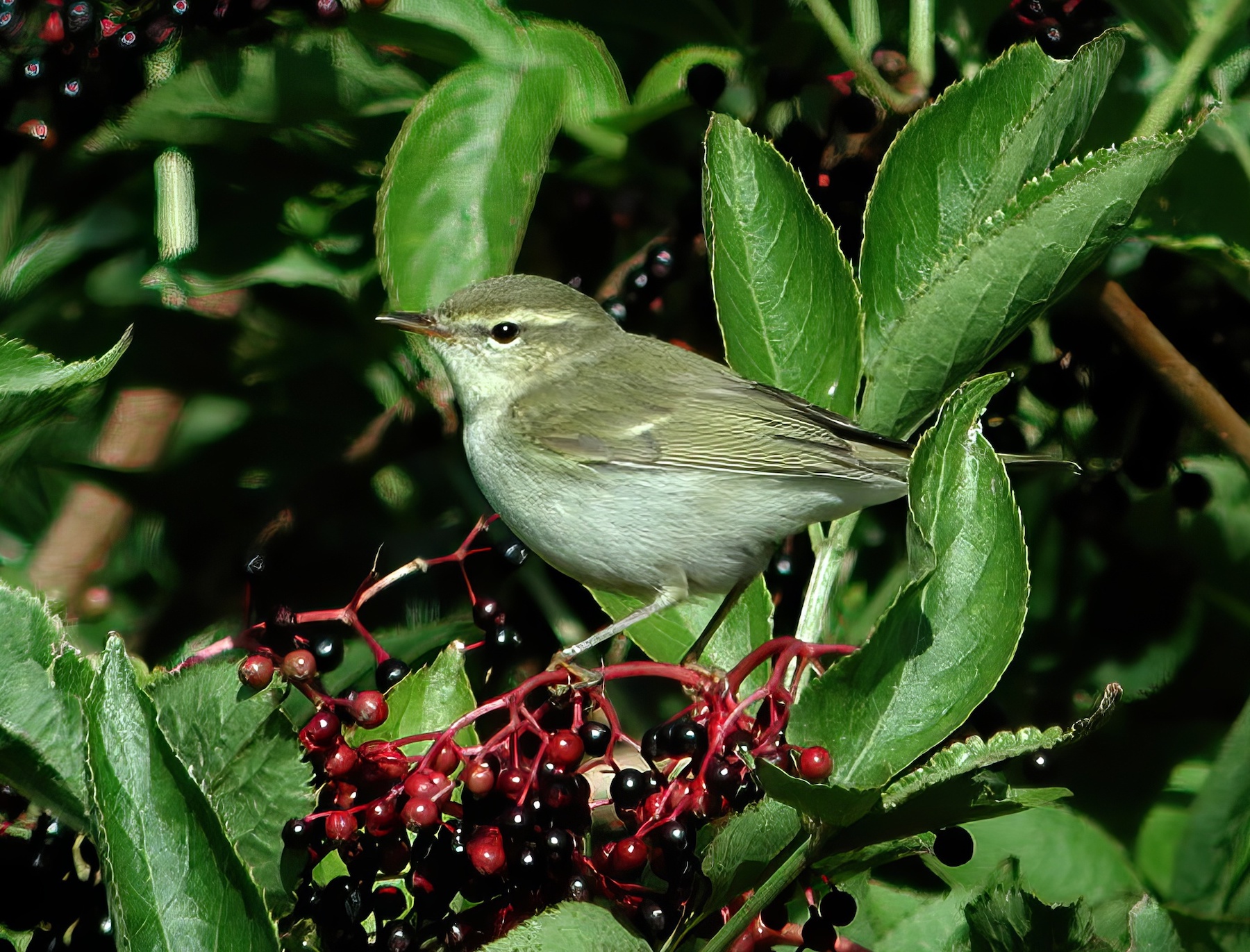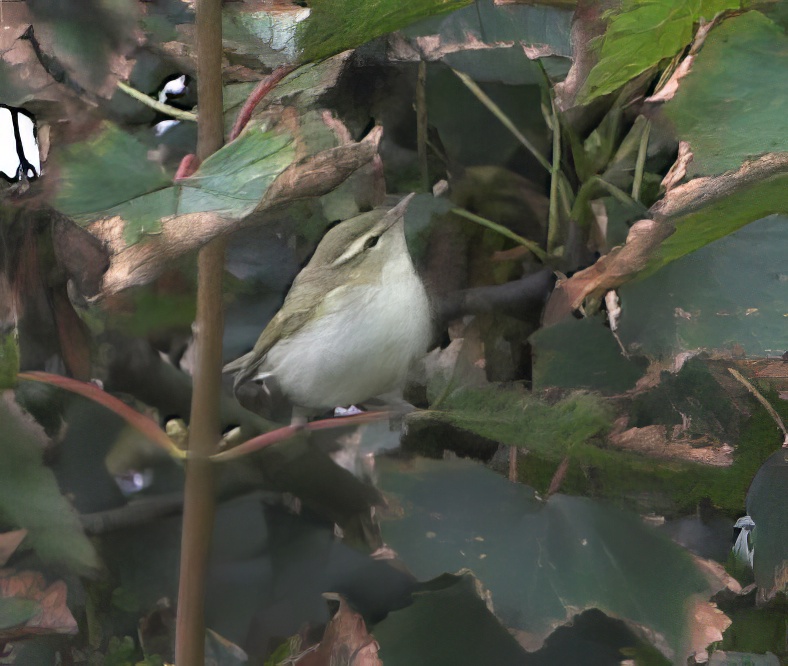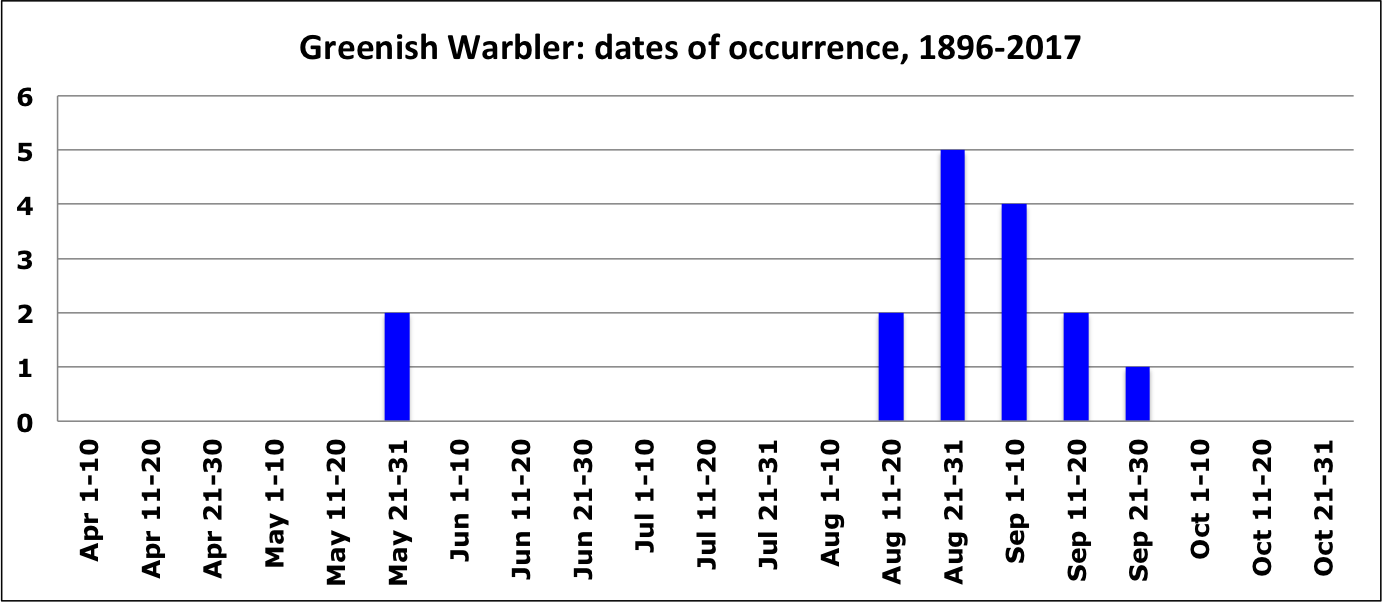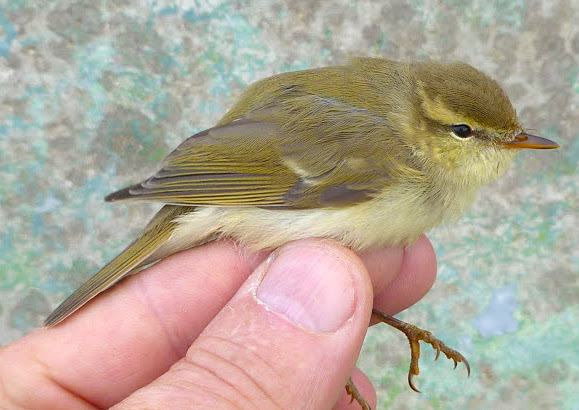Greenish Warbler Phylloscopus trochiloides
Rare. The Baltic eastwards to western Siberia, central-eastern Himalayas and central Asia.


Greenish Warblers: left, Donna Nook September 10th 2002 & centre, Saltfleet Haven 11th September 2005 (Graham Catley); right, Gibraltar Point August 16th 2016 (George Gregory)
Caton Haigh shot the first Greenish Warbler in 1896 (also the first British record), recorded in a short note in the 37th meeting of the Bulletin of the British Ornithologists Club at Restaurant Frascati, London, October 21st 1896:
Mr. G. H. Caton Haigh exhibited a specimen of Phylloscopus viridanus shot by himself on the 5th of September (1896) at North Cotes, Lincolnshire. This Asiatic species was new to Great Britain, but had occurred three times on Heligoland.
There was a long gap until the second which was trapped at Gibraltar Point in 1958 and the rest followed somewhat erratically. There were three in 1976 and two in both 1977 and 1981 but otherwise there has been no more than one per year. Most (see chart below) have appeared within a fairly short period of early autumn, with extreme dates of 14th August and 22nd September, but a couple of birds have been found in spring, at Gibraltar Point on 29th-31st May 2013 and at Donna Nook on 31st May 2014. All have been along the coast from Donna Nook to Gibraltar Point, including three at Donna Nook, four at Saltfleet/Saltfleetby and six at Gibraltar Point.
Greenish Warbler is a rare but regular vagrant to the UK and has averaged about 20 records a year since 2000. There were influxes in 2005 and 2007 (which all but by-passed Lincolnshire) when there were 47 and 42 records respectively. Most occur along the east coast with a small peak late May-early June (5-10% of all records; usually singing males) and a larger one from mid-August to mid-September. The large arrival in 2007 was almost entirely confined to Norfolk accounting for an amazing 34 of the 42 national records that year. Since 2005, the species has no longer been considered by BBRC.
| Site | First date | Last date | Count | Notes |
| North Cotes | 05/09/1896 | 1 | Shot; adult female on dissection | |
| Gibraltar Point NNR | 03/09/1958 | 1 | Trapped | |
| Anderby Creek | 14/08/1976 | 1 | Trapped | |
| Saltfleetby-Theddlethorpe NNR | 22/08/1976 | 1 | ||
| Donna Nook | 23/08/1976 | 1 | ||
| Saltfleetby-Theddlethorpe NNR | 21/08/1977 | 22/08/1977 | 1 | |
| Seacroft | 23/08/1977 | 24/08/1977 | 1 | Trapped |
| Saltfleetby-Theddlethorpe NNR | 31/08/1981 | 1 | ||
| Gibraltar Point NNR | 02/09/1981 | 04/09/1981 | 1 | Trapped |
| Gibraltar Point NNR | 22/09/1984 | 1 | Trapped | |
| Donna Nook | 10/09/2002 | 13/09/2002 | 1 | |
| Saltfleet Haven | 11/09/2005 | 1 | ||
| Gibraltar Point NNR | 17/08/2008 | 1 | Male singing intermittently | |
| Gibraltar Point NNR | 13/09/2009 | 1 | ||
| Gibraltar Point NNR | 15/09/2009 | 17/09/2009 | 1 | Presumed same bird as on September 13th |
| Saltfleetby-Theddlethorpe NNR | 18/09/2009 | 1 | ||
| Gibraltar Point NNR | 28/08/2012 | 1 | ||
| Gibraltar Point NNR | 29/05/2013 | 31/05/2013 | 1 | Adult male, trapped, in song on 31st. |
| Donna Nook | 31/05/2014 | - | 1 | Trapped |
| Gibraltar Point NNR | 16/08/2016 | - | 1 | Trapped |
| Saltfleetby-Theddlethorpe NNR | 19/09/2022 | - | 1 |

Finder’s report: Greenish Warbler at Gibraltar Point, September 3rd, 1958: second county record.
by A. D. Townsend, F. Norris, L. Cornwallis, L. Cave, et al.
Note: this is an account of the second Lincolnshire record of a Greenish Warbler and the first for which a 'finder’s account' exists, as far as we know; it is taken from the original BBRC submission.
Circumstances
Weather conditions: a strong force 5-6 easterly wind had been blowing throughout the night of the 2nd/3rd September which resulted in ideal drift conditions. The movement was on a large scale and included Pied Flycatchers, Redstarts, Wrynecks, a Bluethroat, and Willow Warblers. A small Phylloscopus warbler was caught in the main trap at 10.30hr.
Description
In the hand the bird appeared very small compared with a Willow Warbler caught at the same time. A distinct creamy-white wing-bar, which was formed by the pale tips of the greater coverts, excluded Chiffchaff or Willow Warbler. Wings and tail brown, upperparts greenish-brown. Underwing coverts yellowish-white. This bird had a definite yellow eye stripe. Ear coverts yellow, tinged with brown. Bill brown, lower mandible horn colour. Legs brownish-grey. Underparts yellowish-white. The bird did not call when released. During the afternoon a small leaf warbler with a wing bar was seen in the bushes by LC, which was perhaps the same bird.
Biometrics
Wing length 60mm.
First primary exceeded covert by 8mm. Third, fourth and fifth primary were about equal in length.
Third to sixth primary emarginated on outer web.
Tail x 100/Wing = 75.
Wing formula almost the same as Chiffchaff.
References
Bird Guides (2021). Focus on: Greenish Warbler. https://www.birdguides.com/articles/species-profiles/focus-on-greenish-warbler/.
Bowdler-Sharpe, R. (1896). Bulletin of the British Ornithologists Club XXXIII, pVIII.
Cordeaux, J. P. (1899). A List of British Birds belonging to the Humber District. R.H. Porter, London.


